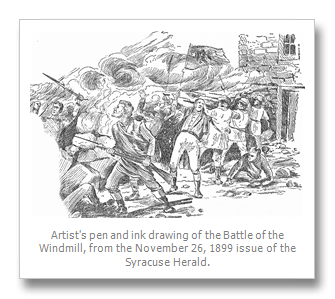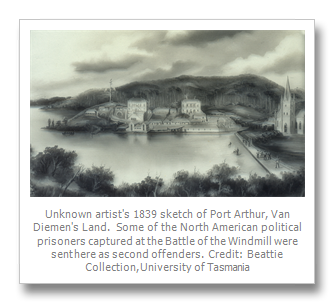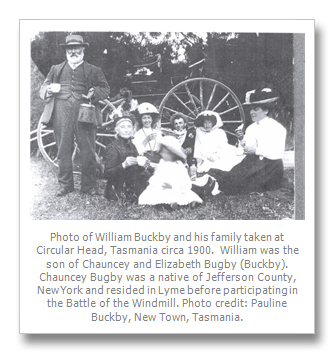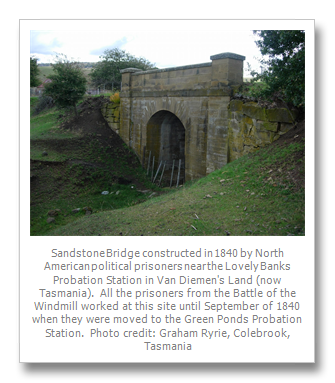Remembering the Battle
Written by John C. Carter posted on November 13, 2013 07:35
Patriot Chronicles: Remembrances of the Battle of the Windmill
November 12 to 16, 2013 marks the 175th anniversary of the Battle of the Windmill. Much was written about this incident in Canadian, American and even Australian newspapers of the time. The second last incursion associated with the 1838 Upper Canadian Rebellion, has also been detailed in more recently published books and articles (see suggested reading list for examples of both).
As with the chronicling of any historical event, first-hand recollections and remembrances printed in period newspapers and journals were written for different reasons and from varied perspectives. It is therefore important to reflect upon the goal of the authors, and to try and decipher the original purpose of those who put pen to paper. This article will present a sampling of some of these contemporary accounts, and provide leads to other sources of contemporary research.
It didn’t take long for news of the Battle of the Windmill to be circulated widely in the popular press. An Extra edition of the [Kingston] Upper Canada Herald was published on November 17. An unnamed loyalist observer provided graphic details of the battle, and concluded that the action “...soon ended in the complete destruction of the pirates, who have left above 60 dead bodies on the ground.”
A November 17th and 18th description of the raid written by a United States officer stationed aboard the American armed steamer Telegraph, was printed in the November 29th issue of the Army and Navy Chronicle. It provided an impression made upon this witness of the readiness of the Upper Canadian militia to resist an attack upon the province, and is evidence of the efforts made by the United States government to enforce its neutrality laws. At the end of the battle the officer noted; “We shortly returned to port, and beheld the whole town of Prescott brightly ILLUMINATED. What a commentary on patriotism, that these people should illuminate their houses, because their deliverers had been slaughtered! Need we more than this to convince us that the people of Canada are not disaffected?”
 The [Kingston] Chronicle & Gazette of December 5, provided details of the Militia Court Martial and trial of Patriot prisoners held at Fort Henry. It also included an extract of a November 21 letter from Sackets Harbour, New York published in the New York Commercial Advertiser. In part it questioned “the late Prescott affair” and the common sense of that incursion. It concluded by observing: “Will not this sad lesson open the eyes of our people, and induce them to respect the laws of their own country, instead of periling their lives and honor on such promises of 150 acres of Canada land and 24 dollars bounty?...Not a Canadian joined them, but on the contrary fought them bravely and whipped them soundly.”
In a December 8 letter to his father in Scotland, Lieutenant Andrew Agnew of the 93rd Highland Regiment provided a different military perspective. After months of tedious garrison duty, Agnew expressed a strong desire to engage the Patriot forces. As an actual participant fighting on the government side, Agnew provides a fascinating day by day account of the action. He speaks highly of his military superiors and the militia, and offers a numerical summation of the casualties; “Total killed were 2 officers and 13 men. About 40 wounded. Of the rebels the numbers are uncertain as they threw their dead into the river the morning of the armistice. 15 bodies were left on the field, many must have been burned and several died afterwards of wounds. We had about 150 prisoners.” Lieutenant Colonel Ogle Robert Gowan, leader of the Orange Lodge in Upper Canada, was also directly involved in the battle. He had portions of his account printed in the December 8 issue of Mackenzie’s Gazette. Gowan’s observations provide yet another version of events from the perspective of the militia, and portray its role during the fighting which took place on November 13, 1838.
Another rich source of information reflecting the loyalist position is the journal of First Lieutenant Charles Allen Parker of the Royal Marines (published by the Kingston Historical Society in 2009). As a nineteenth-century military officer, Parker was trained to be an astute observer and an accurate communicator, and what he records in his diary reflects these attributes. Parker had command of 65 men. On engagement with the enemy forces, they faced sustained rifle fire from Patriot snipers holed up in the stone buildings at the windmill site. During the battle Parker was wounded in the arm and narrowly avoided being killed when another bullet passed through the hair on the side of his head. Parker postulated that the rebels targeted him because he was an officer, and he wrote; “I felt at this time that I had been marked, my dress distinguishing me: the three men nearest me were struck about the same moment.” From his company, five men died and twenty-two received wounds during the initial battle. Later on leaving the field after victory, Parker recorded that 13 soldiers had been killed and 62 wounded. He surmised that the troops under his command had killed or seriously wounded at least 30 of the Patriot force. No love was lost for his adversaries. Subsequently when orders for a Court Martial were given for the trial of prisoners to commence, Parker concluded; “How gratifying to the devotedly loyal inhabitants of this province, to see their enemies defeated, - totally defeated from east to west, from one extremity to the other of their province. Loyal Canadians! If those whose hearts ought to teem with gratitude, look coldly on your deeds an approving conscience will be your reward.” His positive feelings for the loyalty of most Upper Canadians and the defeat of the Patriots were steadfast.
 Not to be out done, newspapers supporting the Patriot cause also soon had first-hand accounts published telling their version of the events associated with the Battle of the Windmill. From November 24 until the end of 1838, Mackenzie’s Gazette printed numerous articles, reports and excerpts from American newspapers. In a December 1 letter to the editor, an anonymous observer reported that on November 13, Patriot forces numbering 128 “stood their ground, facing between 600 and 800 British regulars and volunteers,” eventually driving “the British back into the fort with a loss of over 100 dead on the field, and three times that number wounded.” A journal of events written by Canadian born Patriots James Philips and Alexander Wright who were participants in the battle, appeared in the December 1 Gazette. Both men were killed in action on November 13 and 16 respectively. In addition, a British account of the Prescott hostilities was re-printed from an original article in the November 17 [Kingston] Upper Canada Chronicle. Private correspondence from Ogdensburg on November 26, supplied additional primary information from an American perspective in the following week’s edition of the Gazette. Patriot “General” J. Ward Birge, commander of the “late unfortunate attempt to assist the Canadians,” sent his personal reflections about the battle in a letter to the editor, William Lyon Mackenzie. This narrative was printed in the Gazette of December 22, 1838.
The Gentleman’s Magazine was one of the first British journals to report on the Battle of the Windmill. In the January 1839 edition, the following account was published: “Accordingly, on the night of the 11th....800 republican pirates embarked in two schooners at Ogdensburgh, fully armed, and provided with six or eight pieces of artillery, to attack the town of Prescott, on the opposite side of the river. They failed in the attempt to disembark at Prescott; but by the aid of two United States’ steamers, effected a landing a mile or two below the town, where they established themselves in a windmill and some stone buildings, and repelled the first attempt to dislodge them, killing and wounding forty-five of their assailants, among whom were five officers; but on the 15th, Col. Dundas brought a reinforcement of regular troops, with three pieces of artillery, against the invaders. From the water they were fired upon by Captain Sandom, who had two gun-boats; and, after enduring the attack for about an hour, they hung out their flag of truce and surrendered at discretion.”
After hostilities had officially subsided, Mackenzie continued to publish related stories. His Gazette of October 24, 1840 included a story on the “Attempt to Save Von Shultze (sic) & the Brave Boys in the Wind-Mill,” and featured a narrative of Ogdensburg’s postmaster Preston King and his “Heroic Conduct” in that episode of the Patriot War. Even more amazing was the publishing of Sebastian John (Meyer) Myer’s short “Narrative of the Expedition to Prescott and Wind Mill Point,” in the Gazette of November 14. Myer was a 21 year old native of Germany who had been living in Syracuse, New York prior to joining up with the Patriot forces, supposedly as a cook. He was captured, found guilty, sentenced to death, then recommended for mercy, and eventually pardoned. He moved to Rochester, where he wrote about his experiences related to his involvement in the Battle of the Windmill. He sent them to Mackenzie to be published on November 11, 1840, almost two years to the date of the actual incursion! Myer, along with William Gates, Daniel Heustis and Stephen Wright are the only known Patriot participants at the Battle of the Windmill to have had their recollections and memoirs published. It is conceivable that Mackenzie assisted Myer in composing the piece. If so, the timing of its publication was not surprising. Mackenzie must have hoped that in printing Myer’s article that he could shore up the flagging fortunes of his newspaper. His efforts were unsuccessful, as the November 14 offering became the penultimate issue of the Gazette.
 Myer suggested that it was not yet time for him to comment on the conduct of the English government regarding what he called the “brave and innocent patriots,” and to address the transporting of his colleagues and others to the penal colony of Van Diemen’s Land. He concluded his narrative by asking a question in poetical form: “Shall Canada fall as Poland did, And shall the heavenly spark be hid, Which fired the Patriot host – Shall Queen Victoria’s vaunted claim, And bloody flag, deep died in shame, Still move around our coast? Say, shall she boast that in her might, She trampled on that holy right, Which your forefathers won; And shall their sons with dastard mien, Stand trembling near the bloody scene, And not to conquest run?”
This was not the first verse to be written and published about the Battle of the Windmill. Gavin Russell, a sergeant in the 2nd Regiment Grenville Militia, wrote a twenty page epic poem regarding his thoughts and sentiments of the events. This lengthy tomb was published in Montreal in 1839. Soon after the battle, a traditional song began to circulate which acknowledged the “success” of the British regular troops and the Canadian volunteers and militia who had “triumphed” over the primarily foreign invading forces.
In a strange quirk of fate, the site of the battle became a favoured destination for travellers to the immediate area. Englishman Thomas Sibbald passed by aboard a narrow propeller canal boat on September 18, 1842. He recorded the following: “During the early part of the night we passed Prescott, the roofless buildings, visible by moonlight, tell of a party of rebels or brigands under Van Schultz (sic), a Pole, who crossed the St. Lawrence on the night of the 14th November, 1838, and took possession of a strong stone windmill, a little below the town, the provisional militia had kept them in check, until troops and guns could be sent from Brockville. On the morning of the 15th a simultaneous attack was made by land and water, and the result was the capture of the mill, though the loss was very great on the side of the assailants, considering that their foes fought with halters around their necks. Many of the brigands were killed, those who survived were taken prisoners, among them, Van Schultz (sic), who with five of his officers was executed at Kingston.”
Captain Sir James E. Alexander of the 14th Regiment of Foot and his wife Lady Alexander, actually visited the site where the battle took place on a journey made in 1842. He noted that; “Here the American ‘Sympathizers’ had made a bold attempt to establish a footing in Canada.” Alexander claimed that 400 Patriots had embarked from Sackets Harbour, New York, to engage British troops lead by Colonel Plomer Young and an armed steamer under the command of Captain Williams Sandom. Alexander recorded that 18 British soldiers were killed. He also viewed a stone slab near the ruins of the windmill which bore the following inscription: “Patriots Stop And Shed A Tear! In Memory of the Brave Patriots Who Fell In Defence Of Liberty At Windmill Point, In The Year 1838. Where Liberty Dwells, There Is My Country. Woe To Britain!”
Personal remembrances later published about what Ralph Jones, captain of the steamer William IV reportedly witnessed (see Ogdensburg Daily Journal of August 2, 1880), and what contemporary chronicler and correspondent A.M. St. Germain purportedly saw (see St. Lawrence Republican & Ogdensburg Weekly Journal of December 26, 1888), were questioned for the accuracy and details of their accounts. Numerous articles in Australian and Van Diemen’s Land papers were published in April and May of 1839. They would be of little solace for participants at the Battle of the Windmill, those who had been sentenced for their participation, or for those who were preparing for transportation to Van Diemen’s Land as political prisoners.
The passing of time has clouded memories and recollections of the events associated with the Battle of the Windmill. General history books for the most part do not do a good job in recording nor accurately portraying these facts. This and other incursions linked to the 1838 Upper Canadian rebellion are often neglected or overlooked in school history lessons. However, in November 2013 we have the opportunity to commemorate the 175th anniversary of these events. By doing so, we can again remember one of the most significant actions associated with the Patriot War and the Upper Canadian Rebellion of 1838.
Suggested Reading:

- James E. Alexander. L’Acadie or Seven Years’ Explorations in British America (London: Henry Colburn, 1849), v. 1.
- Robert J. Andrews & Rosalyn Parker Art (eds.). “A Troublesome Berth”: The Journal of First Lieutenant Charles Allan Parker (Kingston: Kingston Historical Society, 2009)
- J. Ward Birge. “General Birge’s Account of the Prescott Expedition,” Mackenzie’s Gazette (December 22, 1838).
- Chee-Mang-A-Nish. “Canada,” Army and Navy Chronicle (November 29, 1838), v. 6.
- James Croil. “The Battle of the Windmill,” Brockville Recorder (August 18, 1868).
- Ogle R. Gowan. “The Battle of Prescott,” Mackenzie’s Gazette (December 8, 1838).
- William Gates. Recollections of Life in Van Diemen’s Land (Lockport,N.Y.: C.S. Crandal, 1850).
- Donald E. Graves. Guns Across the River (Toronto: Robin Brass Studio, 2001).
- Ernest Green. “The Song of the Battle of the Windmill,” Ontario Historical Society Papers and Records (1942), v. 34.
- Daniel D. Heustis. Narrative of the Adventures and Sufferings of Daniel D. Heustis (Boston: S.W. Wilder, 1848).
- Preston King. “Attempts to Save Von Schultze & the Brave Boys in the Windmill,” Mackenzie’s Gazette (October 24, 1840).
- Shaun J. McLaughlin. The Patriot War Along the New York – Canada Border (Charleston: The History Press, 2012).
- Scott A. McLean. “The Battle of the Windmill Revisited as recounted by Lieutenant Andrew Agnew, 93rd Highland Regiment of Foot, 8 December 1838,” Canadian Military History (Autumn, 2000), v. 9, #4.
- Sebastian John Meyer. “A Narrative of the Expedition to Prescott and Wind Mill Point,” Mackenzie’s Gazette (November 14, 1840).
- n.a. “The Battle of Prescott,” Mackenzie’s Gazette (December 1, 1838).
- n.a. “The Battle of the Windmill,” The [Cobourg] Church (November 24, 1838).
- n.a. “Battle of the Windmill,” [Ogdensburg] Daily Journal (June 22, 1905).
- n.a. “The Battle of the Windmill,” Ogdensburg Journal (July 3, 1909).
- n.a. “Battle of the Windmill,” [New York] St. Lawrence Republican (July 7, 1909).
- n.a. “Battle of the Windmill Fought 83 Years Ago,” Cape Vincent [New York] Eagle (December 1, 1921).
- n.a. “British Account of the Battle of Prescott,” Mackenzie’s Gazette (December 1, 1838).
- n.a. “Canada War. Defeat of th Patriots at Windmill Point Confirmed,” Sydney Herald (April 8, 1839).
- n.a. “Destruction of the Rebels,” [Kingston] Upper Canada Herald – Extra (November 17, 1838).
- n.a. “Fifty-One Years Ago. A Reminiscence of 1837 – Some of the Effects of the Rebel Scare,” The [New York] St. Lawrence Republican & Ogdensburg Weekly Journal (December 26, 1888).
- n.a. “Historical Chronicle. Foreign News. Canada.,” Gentleman’s Quarterly (January, 1839), v. 11, n.s.
- n.a. “Important From Canada – Extension of the Rebellion to the Upper Province – Engagement at Prescott – Repulse of the Royal Troops,” [Sydney] Australian (April 4, 1839).
- n.a. “Latest English News,” Sydney Herald (April 3, 1839).
- n.a. “Newell Tells About Battle of Windmill,” Ogdensburg Journal (July 2, 1938).
- n.a. “Old Paper Describes ’38 Battle,” [Ogdensburgh] Advance-News (May 27, 1957).
- n.a. “The Patriot War,” St. Lawrence [New York] Republican & Ogdensburg Weekly Journal (November 26, 1884).
- n.a. “Preparations For The Attack on Prescott,” & “The Battle of Prescott,” Sydney Monitor & Commercial Advertiser (April 10, 1839).
- n.a. “The Prescott Prisoners – Canada,” Mackenzie’s Gazette (December 1, 1838).
- n.a. “Prisoners Taken at Prescott,” Mackenzie’s Gazette (December 1, 1838).
- n.a. “Private Correspondence,” Mackenzie’s Gazette (December 8, 1838).
- n.a. “The Song of the Battle of the Windmill,” [Ogdensburgh] Advance-News (August 20, 1938).
- n.a. “Upper Canada. Government House Toronto, Nov. 15, 1838,” Hobart Town Courier (May 3, 1839).
- James Philips & Alexander Wright. “The Battle of Prescott,” Mackenzie’s Gazette (December 1, 1838).
- Gavin Russell. Thoughts and Sentiments Connected with the Invasion of Upper Canada, by a Band of Lawless and Unprincipled Men (Montreal: Campbell & Beckett, 1839)
- Stuart D. Scott. To the Outskirts of Habitable Creation (New York: iUniverse, 2004).
- Thomas Sibbald. “Extracts From a Few Days in the United States and Canada with Some Hints to Settlers,” Women’s Canadian Historical Society of Toronto Annual Report 1916/1917 (1918).
- A.M. St. Germain. “A Remembrance of 1837 – Some of the Effects of the Rebel Scare,” St. Lawrence [New York] Republican & Ogdensburg Weekly Journal (December 26, 1888).
- Charles P. Stacey (ed.). “An American Account of the Prescott Raid of 1838,” Canadian Defence Quarterly (1932), v. 9.
- T.W. “The Battle of the Windmill,” [Ogdensburg] Daily Journal (August 2, 1880).
- George C. Wells. “The Battle of Windmill Point,” Canadian Magazine (1916), v. 47.
- Stephen S. Wright. Narrative and Recollections of Van Diemen’s Land (New York: New World Press, 1844).
By Dr. John C. Carter, drjohncarter@bell.net
Dr. John C. Carter is a Director of the Ontario Historical Society and a Research Associate in the History and Classics Programme, University of Tasmania. This is his seventh article written for TI Life (Click here view his other articles). In particular his February 2013 Patriot Chronicles: The Hickory Island Incursion and April 2013 The Burning of the “Sir Robert Peel”… set the scene for this important period of history.
In addition Dr. Carter has provided a bibliography to study this important era of Thousand Islands history which can be found in THE PLACE, History page.
Please feel free to leave comments about this article using the form below. Comments are moderated and we do not accept comments that contain links. As per our privacy policy, your email address will not be shared and is inaccessible even to us. For general comments, please email the editor.
Comments
Comment by: Pauline Buckby ( )
Left at: 5:50 PM Tuesday, November 19, 2013
If it hadn't been for Dr. Carter's articles few Tasmanian's would have known about the Patriots who came out to out country as prisoners. Australians have been so involved with our own convict history from the UK. the Patriots would had gone unnoticed to our present generation in spite of the monuments to their memory in our parks. I was fascinated by the history of the battle and am grateful for Dr.Carter's articles.

Comment by: Joan (Stone) Jakubowski
Left at: 6:30 AM Tuesday, February 24, 2015
Praise this work, there is none other like it, a professional display of works that is bringing closure to the many dead from both sides of the battles. The bloated stories presented by both sides were political in nature, the accounts by the prisoners sent to Tasmania do give a more accurate description of the many battles from the waterways of Michigan to Vermont. When the records of Alexander Stone (about 1810-1893), buried in Brookside Cemetery, Waddington, St Lawrence, NY are found, another accurate piece of history can be told. Alexander Stone and family, a tinsmith, are found in the 1851 census of Canada, found next in the 1860 Census in St Lawrence County, NY. This census shows my Grandfather Franklin Benjamin Stone, who died 1903, death from the result of falling from a hot air balloon that became untethered, three years earlier. This was at a celebration in the firing of a cannon to commemorate this event. I have in my possession, the Wills of three of the dead, the lawyer that wrote the wills, and the records of families that moved away. Thank you Dr. Carter.
|